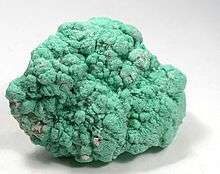Vanadium phosphate
| Identifiers | |
|---|---|
| (dihydrate), 12359-27-2 (anhydrous) 12293-87-7 (dihydrate), 12359-27-2 (anhydrous) | |
| Properties | |
| H4O7PV (dihydrate) | |
| Molar mass | 197.94 (dihydrate) |
| Appearance | yellow solid (dihydrate) |
| insoluble | |
| Except where otherwise noted, data are given for materials in their standard state (at 25 °C [77 °F], 100 kPa). | |
| Infobox references | |
Vanadium phosphate is an inorganic compound with the formula VOxPO4 and related hydrates (x = 0 or 1). A common vanadium phosphate is VOPO4.2H2O. Four polymorphs are known for anhydrous VOPO4, denoted α, β, γ, δ. These materials are composed of the vanadyl group (VO) and phosphate (PO43-). They are yellow, diamagnetic solids, although when contaminated with vanadium(IV) derivatives, samples exhibit EPR signals and have bluish cast. For these materials, vanadyl refers to both vanadium(V) oxo and vanadium(IV) oxo centers, although conventionally vanadyl is reserved for derivatives of VO2+.
2_(no_hydrogen_shown).tif.png)
Vanadium(IV) phosphates
Related compounds contain vanadium(IV), and are typically blue. In these species, the phosphate anion is singly or doubly protonated. Examples include the monohydrogenphosphates, VOHPO4.4H2O and VO(HPO4).0.5H2O, and the dihydrogen phosphate VO(H2PO4)2).
0.5H2O.tif.png)
Vanadium(III) phosphates
Vanadium(III) phosphates lacking the oxo ligand]] have the formula VPO4.H2O and VPO4.2H2O. The monohydrate is isostructural with MgSO4.H2O.[2] The dihydrate occurs naturally as the mineral metavariscite; it adopts the structure of the corresponding hydrated aluminium phosphate.

Preparation, reactions, and applications of VOPO4.2H2O
Heating a suspension of vanadium pentoxide and phosphoric acid gives VOPO4.2H2O, isolated as a bright yellow solid.[3] According to X-ray crystallography, the V(V) centers are octahedral, with a long, weak bond to an aquo ligand.[4]
Reduction of this compound with alcohols gives the vanadium(IV) phosphates.
These compounds are catalysts for the oxidation of butane to maleic anhydride. A key step in the activation of these catalysts is the conversion of VO(HPO4).0.5H2O to the pyrophosphate (VO)2(P2O7). This material (CAS#58834-75-6) is called vanadyl pyrophosphate as well as vanadium oxide pyrophosphate.[5]
References
- ↑ Koo, H.-J.; Whangbo M.; VerNooy, P. D.; Torardi, C.C.; Marshall, W.J. "Flux Growth of Vanadyl Pyrophosphate, (VO)2P2O7, and Spin Dimer Analysis of the Spin Exchange Interactions of (VO)2P2O7 and Vanadyl Hydrogen Phosphate, VO(HPO4)·0.5H2O" Inorganic Chemistry 2002, volume 41, p4664-4672. doi:10.1021/ic020249c
- ↑ Vaughey, J.T.; Harrison, W.T.A.; Jacobson, A.J.; Goshorn, D.P.; Johnson, J.W. "Synthesis, structure, and properties of two vanadium(III) phosphates: V(PO4).H2O and V1.23(PO4)(OH).69(H2O).31-0.33H2O" Inorganic Chemistry 1994, vol. 33, p2481-2487. doi:10.1021/ic00089a027
- ↑ John F. Brody, Jack W. Johnson,"Vanadyl Phosphates and Organylphosphonates" Inorganic Syntheses, 1995, volume 30, pages: 241–248. doi:10.1002/9780470132616.ch45
- ↑ Tietze, H.R. "The crystal and molecular structure of oxovanadium(V) orthophosphate dihydrate, VOPO4(H2O)2" Australian Journal of Chemistry 1981, volume 34, p2035-2038. doi:10.1071/CH9812035
- ↑ Dummer, N. F.; Bartley, J. K.; Hutchings, G. J., "Vanadium Phosphate Materials as Selective Oxidation Catalysts", Adv. Catal. 2011, volume 54, 189-247. doi:10.1016/B978-0-12-387772-7.00004-6